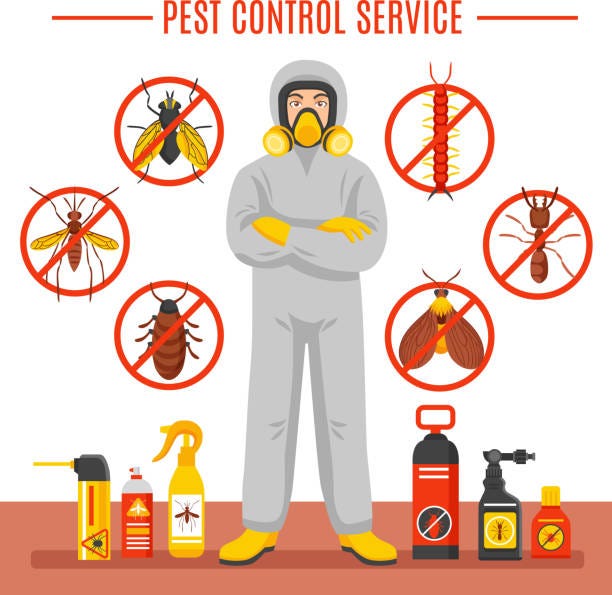Wiping Out Pests: Leading Pest Control Visalia's Experts
Wiping Out Pests: Leading Pest Control Visalia's Experts
Blog Article
Types of Insect Control: Which Method Is Right for Your Invasion?
When encountered with an insect infestation, the choice of a proper method for bug control is critical in efficiently taking care of the situation. By checking out the various types of parasite control methods offered, people can make informed decisions customized to their unique scenarios, ensuring a much more effective and sustainable end result in bug eradication.

Chemical Insect Control
Chemical bug control includes using artificial or naturally obtained chemicals to manage and get rid of pest populaces properly. This approach is commonly made use of in farming, forestry, and residential setups to battle a vast array of parasites, consisting of insects, rodents, and weeds. Making use of chemical pesticides can give quick and targeted solutions to pest problems, making it a prominent choice for many people and organizations.
Among the essential advantages of chemical insect control is its ability to swiftly remove parasites, reducing the risk of damages to crops, building, and human wellness - pest control visalia. By utilizing particular chemicals that target particular bugs, this technique can efficiently control problems while lessening damage to useful organisms and the environment when used correctly
Nonetheless, using chemical pest control additionally raises problems about prospective unfavorable results on non-target species, water resources, and human health and wellness. It is essential to adhere to security standards, apply chemicals properly, and consider different insect control techniques to reduce these threats and guarantee lasting pest administration practices.
Biological Bug Control
Organic bug control, likewise understood as biocontrol, utilizes living microorganisms to lower and manage bug populations normally. This approach utilizes the power of nature to regulate insects without the demand for artificial chemicals. Biocontrol can entail the introduction of all-natural enemies of the bug species, such as predators, bloodsuckers, or microorganisms, to suppress pest populaces. By using the parasite's all-natural predators or microorganisms, biological pest control uses a lasting and ecologically friendly option to pest management.
One common instance of organic pest control is making use of ladybugs to regulate aphid populations in yards. Ladybugs are natural killers of aphids and can aid maintain their numbers in check without using dangerous chemicals. The bacterium Bacillus thuringiensis (Bt) is used as an organic insecticide to manage caterpillar bugs while being secure for various other organisms.
Mechanical Insect Control
Utilizing physical and manual methods to manage parasite populaces, mechanical pest control provides a different technique that does not rely upon making use of living organisms or synthetic chemicals. This technique involves the use of obstacles, traps, or various other gadgets to physically deter or eliminate bugs. By obstructing bug entry factors or establishing catches to catch them, mechanical parasite control can properly reduce invasions without presenting chemicals right into the atmosphere.
One usual instance of mechanical bug control is using mesh displays on doors and windows to stop bugs from getting in structures. pest control visalia. This basic yet efficient approach serves as a physical barrier, keeping bugs out while permitting appropriate ventilation. In addition, gadgets like mousetraps, fly swatters, and ultrasonic repellents drop under the mechanical pest control group

Physical Bug Control
A reliable strategy to managing insect populations without depending on chemical or biological techniques includes using physical parasite control methods. Physical bug control methods aim to eliminate or prevent bugs via mechanical methods instead than chemicals or pesticides. These techniques are frequently preferred for their ecologically pleasant nature and marginal effect on non-target organisms.
Some typical physical parasite control techniques consist of using barriers such as nets or displays to prevent parasite entry, traps to capture and get rid of insects, and hand-picking to literally eliminate insects from plants or frameworks. In addition, strategies like heat treatments can be used to manage bugs like bed insects by elevating the temperature level to degrees that are lethal to the insects.
Physical insect control is specifically beneficial in incorporated bug management (IPM) strategies, where multiple parasite control techniques are integrated for reliable parasite monitoring while lessening making official site use of chemicals. By using physical parasite control methods, people can efficiently deal with pest infestations with minimal ecological influence.
Integrated Bug Management
When applying physical parasite control approaches as part of parasite monitoring methods, Integrated Parasite Management click here for more info (IPM) becomes an extensive strategy that leverages numerous techniques to properly control pest populaces. IPM concentrates on lasting avoidance of pests through a mix of organic, social, physical, and chemical devices customized to details bug concerns. By integrating several control techniques, IPM aims to minimize the threats linked with pests while also minimizing reliance on chemical solutions.

Final Thought
To conclude, determining one of the most efficient technique of parasite control for your problem relies on various factors such as the type of parasite, the level of the infestation, and ecological factors to consider. Chemical bug control includes the use of chemicals, biological insect control utilizes all-natural predators, mechanical bug control includes physical barriers, physical parasite control consists of trapping or removing pests, and incorporated parasite management incorporates several approaches for an all natural method to pest control. Select the method that finest fits your specific scenario.
By making use of the parasite's natural predators or pathogens, organic parasite control supplies a lasting and eco friendly solution to pest administration.
Using manual and physical techniques to take care of pest populaces, mechanical bug control uses an alternative approach that does not rely on the usage of living organisms or artificial chemicals.An efficient method to taking care of bug populations without relying on chemical or biological methods includes the usage of physical insect control techniques.When carrying out physical bug control methods as go to website part of insect management techniques, Integrated Bug Management (IPM) arises as a detailed approach that leverages various techniques to properly manage pest populations. Chemical pest control involves the use of pesticides, organic pest control utilizes all-natural predators, mechanical parasite control includes physical barriers, physical pest control includes capturing or getting rid of insects, and incorporated pest management combines multiple techniques for a holistic approach to pest control.
Report this page